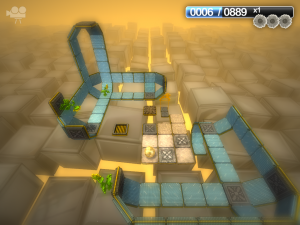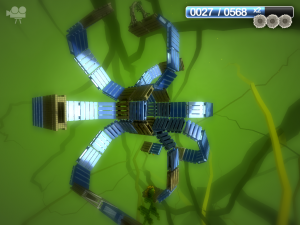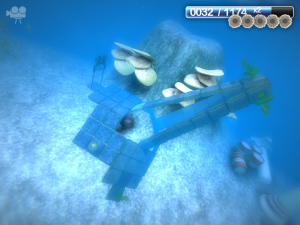Puzzle Dimension: 3D
If there’s one thing Puzzle Dimension really hits home, it’s the dimensionality. This is an experience that’s more fully three-dimensional than most of what we do in real life. I mean, in real life, we’re generally bound to a single surface, with a seemingly consistent normal defining the direction of down. PD lets us explore any surface, regardless of orientation. Let me just share a few illustrative screenshots:
 This level is made mostly of two partial shells, made of pathways along a convex surface, joined by some stepping-stones. Because of the way the shell bends, paths that are partially parallel cross and diverge. The implied hull has a definite inside and outside, with flowers on both, so the player has to seek ways to cross between the two — the hook-shape on the right side is a way to transfer from inside to out, by rolling off the end of the hook and dropping to the other side. Dropping from outside to inside is easier, and can be done in multiple places, but the falls necessary are longer, and more dangerous-feeling, because it’s hard to feel completely sure that things are lined up right over a longer distance.
This level is made mostly of two partial shells, made of pathways along a convex surface, joined by some stepping-stones. Because of the way the shell bends, paths that are partially parallel cross and diverge. The implied hull has a definite inside and outside, with flowers on both, so the player has to seek ways to cross between the two — the hook-shape on the right side is a way to transfer from inside to out, by rolling off the end of the hook and dropping to the other side. Dropping from outside to inside is easier, and can be done in multiple places, but the falls necessary are longer, and more dangerous-feeling, because it’s hard to feel completely sure that things are lined up right over a longer distance.
 There are several levels with this sort of barrel shape. Again, we have a distinct inside and outside (and yes, it is possible to make continuous nonorientable surfaces in this system, although I don’t have a screenshot of one handy), but this time, the design works against maintaining any other sense of orientation: the paths, especially the ones around the curve of the barrel, wind too tightly to easily maintain a sense of absolute direction. Note that the blue tiles are slippery ice; only on the brown tiles can you stop moving. The tentacles here are similar to the hook in the preceding picture, and you can switch from inside to outside by dropping off any of them, but if you’re not careful, you’ll land on an ice tile and go flying off the edge of the structure.
There are several levels with this sort of barrel shape. Again, we have a distinct inside and outside (and yes, it is possible to make continuous nonorientable surfaces in this system, although I don’t have a screenshot of one handy), but this time, the design works against maintaining any other sense of orientation: the paths, especially the ones around the curve of the barrel, wind too tightly to easily maintain a sense of absolute direction. Note that the blue tiles are slippery ice; only on the brown tiles can you stop moving. The tentacles here are similar to the hook in the preceding picture, and you can switch from inside to outside by dropping off any of them, but if you’re not careful, you’ll land on an ice tile and go flying off the edge of the structure.
 This level has a shape that I wouldn’t have thought possible given the game’s constraints: using only 45-degree bends, it produces an elongated three-sided spike. It manages this by constructing three planes that are perpendicular to each other, like the sides of a cube, but whose grid lines are diagonal to the cube’s sides. Before seeing this level, I kind of intuitively assumed that the tiles, regardless of orientation, were part of an overall global 3D grid. But of course this is inconsistent with the observed facts: all tiles are clearly square, so anything situated at a 45-degree angle would break the lines of such a grid. Nonetheless, most levels before this one are arranged more or less rectilinearly.
This level has a shape that I wouldn’t have thought possible given the game’s constraints: using only 45-degree bends, it produces an elongated three-sided spike. It manages this by constructing three planes that are perpendicular to each other, like the sides of a cube, but whose grid lines are diagonal to the cube’s sides. Before seeing this level, I kind of intuitively assumed that the tiles, regardless of orientation, were part of an overall global 3D grid. But of course this is inconsistent with the observed facts: all tiles are clearly square, so anything situated at a 45-degree angle would break the lines of such a grid. Nonetheless, most levels before this one are arranged more or less rectilinearly.
Given the extreme three-dimensionality, it’s especially interesting that the designers decided to make an entire cluster of levels that are flat or mostly flat. I suppose it’s their way of showing that they’re not entirely dependent on disorienting the player, that they can make interesting puzzles even when deprived of their main tool.
 Comments(0)
Comments(0)